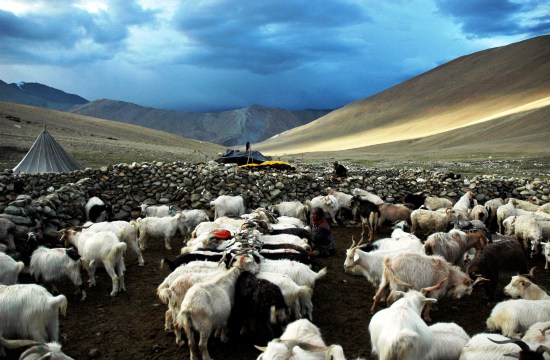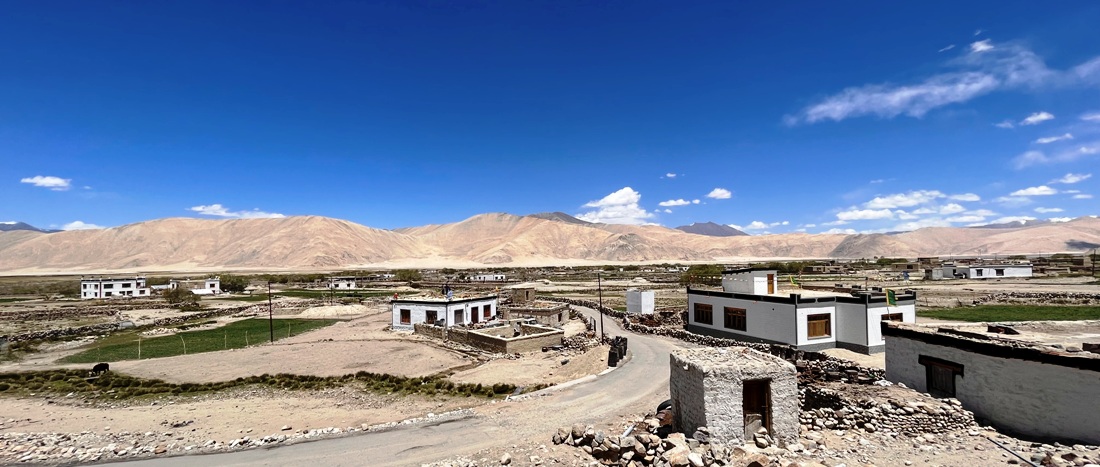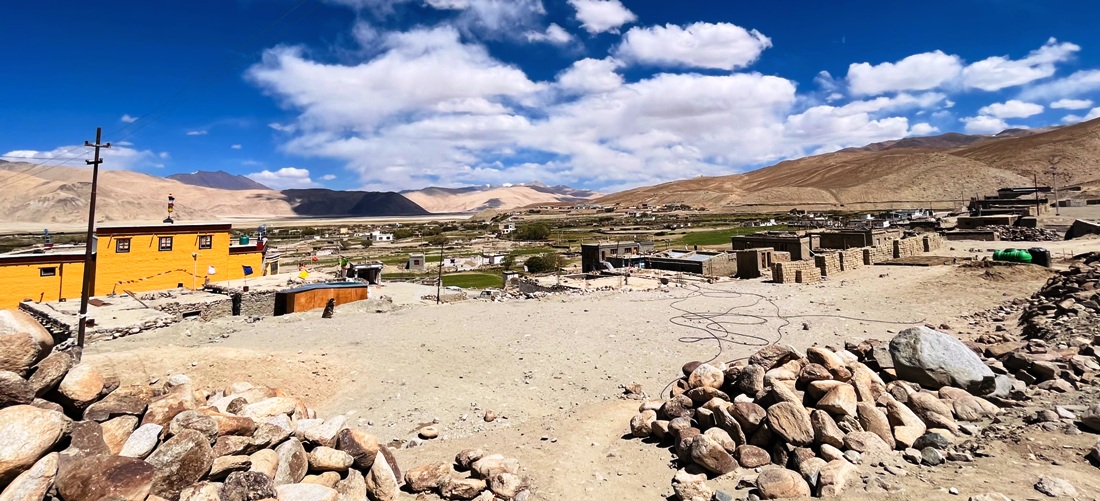The vast cold desert where China and India are involved in a stand-off since May 2020, is home to the most of Changthang goatherds that supply the best Pashmina to the world. Tarushi Aswani visited Chushul and met the herdsmen frustrated over the loss of their livelihoods as they are unable to graze in the pastures they call their own

For years, life for Sonam Tsering, 34, a Changpa nomad, has been a hectic routine – moving with the herd almost round the year. Since the 2020 summer, he is uncertain about his livelihood. He is caught in a crisis. For the last more than two years now, he feels the pain of his hungry herd and cannot take it to the lush green meadows surrounding his Chushul home in Ladakh.
Accessible and within the territorial limits of his region, Tsering cannot afford to tread this beaten path. If he does, he believes he may never return home.
These pastures where the Changpa’s would spend most of the summer with Cashmere goat herds are no-go areas since 2020 after soldiers from China and India fought a pitched battle in the Galwan valley on June 15 night. More than 20 Indian soldiers were killed and many more from China as well. The stand-off led the two sides to push in tens of thousands of soldiers to hold their positions. Red Army has been intruding into these pastures for a long time. In 2020, however, they intruded on May 5, and are still holding part of the Ladakh territory.
Since then, nomads like Tsering are cut off from the pasture lands around the Chushul-Demchok-Chumur, the key belt straddling the Line of Actual Control (LoAC) with China. The area, a literal war theatre, is home to pastoral Pashmina herdsmen who produce almost half of the 45-ton Pashmina wool, a major income to Ladakh periphery.
Finest Pashmina
Changpas are nomadic tribes whose key income comes from the Pashmina wool that Changthang goats produce. Changthang is a vast plateau that is home to the historic access between Leh and Lhasa and has immense strategic importance. Though only a part of the plateau falls on Ladakh side; the people inhabiting the space on either side are making their living by grazing herds. Rearing animals in challenging environments has made these people very hardy, habitual of living in harsh terrain, brave enough to face icy winds, manage snow and have a distinct lifestyle. They say they have evolved with solutions to all the challenges they face but have no answer to how they will survive in a situation in which they have no access to pastures.
In the policy circles of the erstwhile state of Jammu and Kashmir, this area was referred to as the Pashmina plateau because it was crucial to keeping the supply chain of Pashmina wool uninterrupted. The government would fund the dry grass to the herdsmen during winter and early summer when the herds would require it.
After the bifurcation of Jammu and Kashmir that helped Ladakh emerge a new Union Territory, there has been some policy shift. “Ladakh produces almost 50 ton of Pashmina in a year and the best of it (having a micron size of 11 to 15) comes from Changthang,” Mehmood Ahmad, who earlier headed the Handicrafts department said. “The supply is intact but Kashmir consumes less than 30 per cent of Ladakh Pashmina as it imports most from Magnolia and Nepal even though it has no comparison with the Chnagthang produce.”
There were some efforts of having an agreement with the Pashmina producers and consumers as the Government of India had agreed to fund a raw material bank project. Somehow, it has not taken place. This situation has led Leh to sell most of its produce to Himachal, Amritsar and some of the top apparel makers who mix it with other wools. Now the rare wool is caught in a special crisis.

Consistent Fears
“Every once in a while, we hear that China is building structures, towers extremely close to us,” Dorje Nurbo, a nomad who has lost count of the pasturelands they lost to Chinese aggression, said. “For us, it is a very critical situation now that we know there has been no solution the countries have reached. We will be the first to suffer.”
Within two years of the stand-off, External Affairs Ministry has confirmed that Red Army has built a second bridge across the Pangong Tso in eastern Ladakh. Not far away from, the one, they built in January 2022, the new bridge is situated 25 km east of the point of the LoAC. This 400 x 8-metre bridge has robbed many herder’s men of their livelihood in a cold desert where they have no other resource to live upon.
Nurbo’s family has been herding Pashmina goats and yak in lands beyond Chushul that are inaccessible now.
Like Nurbo, Namgyal Phuntsog has suffered due to the severing away of land that has been happening over time. Locals in Durbuk claim that since 2017, the essential patches of grazing grounds of Guntcsay Phu and Tagapank Nak belts have witnessed increased strain between the Indian and Chinese armies, with both mounting their presence in the area.

Rising Risks
Both sides have had efforts to undo the stand-off. India and China have participated in 15 rounds of strategic talks to melt the ice over the mountains and meadows that China has swallowed. So far, however, no ground has broken between the two nuclear powers and region’s two major economies. Notwithstanding the ample strategic, geopolitical and risk value of their location, locals in the region stay put even as the loss of livelihood magnifies their problems. They have been the first line of defence for India but the dramatic shifts have pushed them farther from their pastures.
The PLA initially inched into the 45-km long Skakjung pastureland in the Demchok-Kuyul sector, which lies in eastern Ladakh. Local nomads of Chushul, Tsaga La, Nyoma, Koyul and Loma villages said this robbed off pastureland that fed their 50,000 sheep, goats and 2,000 yaks in the winter grazing schedule.
Now the situation is such that nomads are selling off their livestock in the place of earning a livelihood from it.
Chushul residents said since December 2019, they are being systematically deprived of the Chushul to Dumchele to Kigunaru grazing route. This makes them insecure.

“Whenever any local sees any activity along the border, we alert the army, yet we are being denied access to lands that means our livelihood to us” Dolkar Konchok laments.
“When Galwan clash happened we helped the army, they should trust us,” Phuntsog said while explaining the chain reaction that China’s land hunger has caused. They say that before 2020, they would take their herds beyond Gurung Hill near LoAC and months grazing their goats. “Now, our own army prevents us from grazing our herds in the land that is still in our control.”
Chushul is a remote belt situated at an altitude of 4572 metres, far away from actively urban Leh and accessible through rugged paths. The picturesque brown village is home to around 1100 people, most of whom stay with their herds. Before the standoff, the residents have clear memories of how the Chinese soldiers and civilians would block their entry into the pasturelands. This situation, they say is worse than the 1962 war when the PLA would not bother the herdsmen from the area. “We used to take our herds to Mukhpari and Khaplang, the area now under China,” one resident said. “We are sure that these areas are not Chinese but belong to our ancestors.” They insist that restricting the residents from grazing in the lands is benefiting China and not India.















